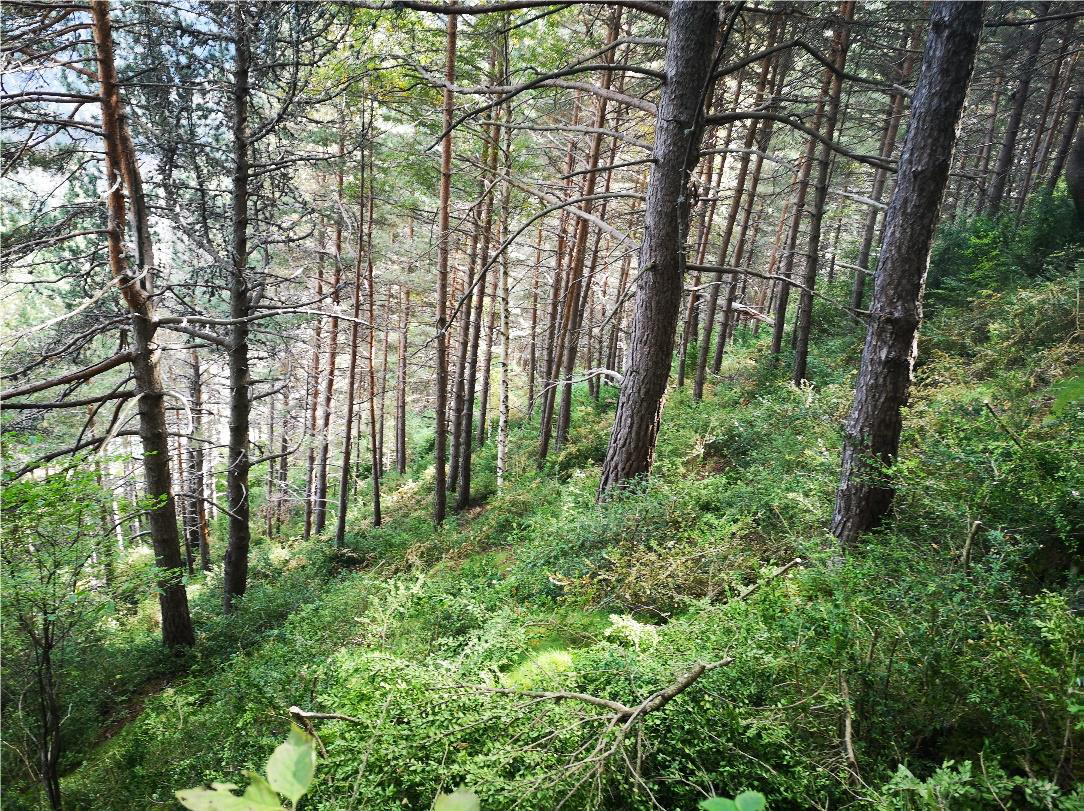One of the key actions of the SUDOE MONTCLIMA project is the design and implementation (testing and development) of common Action Plans for prevention and management of natural hazards, which will be validated and/or improved through pilot trials.
One of these pilot trials, led by FORESPIR and AR+I, is being carried out in a Calcareous mountain scots pine (Pinus sylvestris) forest (Andorra la Vella, Principality of Andorra) the main objective to plan and implement an adaptive forest management action in a protection forest of blocks and rocks, vulnerable to high intensity fires in Andorra. It will also serve as a pilot and demonstration forest of good practices in preventive forestry, to improve the knowledge of these forest structures against the foreseeable impacts of fire risk, and to allow forest managers in the Pyrenees to apply techniques that promote the increase of the resilience of protective forests.

The pilot trial has been carried out at the "Bosc del Maians" forest, located on the northern slope of the parish of Andorra la Vella and covers an area close to 100 ha. The stand, which is entirely on public ownership, starts at the foot of the rocky cliff (number 2, photo 2 and 3) close to the viewpoint "del roc de la Palomera" (number 1, photo 2 and 3) and runs in the direction of the slope until it reaches the picnic area and the site of the water collection infrastructure and artificial hydrant for the defence and fight against forest fires (number 3, photo 2 and 3) at the end of the "Maians" forest track.

For the delimitation of the site and morphology of the 1ha stand, the "risk-exposure unit" method proposed by the French National Forestry Office was used together with an analysis of the slopes and orientation of the slope.
To assess the degree of protection of vegetation against boulder and rock mobilisation, the Hazard Monitoring Index (HMI) was estimated. The HMI takes into consideration the possible impacts of climate change on the forest stand, the current stand characteristics, its resilience, and its natural dynamics. However, it does not incorporate the effects or interaction of other disturbances that could cause a significant alteration in the functioning of the stand, such as the consequences of a forest fire. For the estimation of the HMI, a forest inventory of the study area was carried out in order to characterise the main variables required and a value of 3 was obtained, which corresponds to a medium protection effectiveness of the vegetation against rockfall.
Vulnerability to crown fire is moderate and conforms to the B10 typology defined by Fernandez, et al. (2008). In order to minimise the vulnerability of the forest to crown fires, a series of silvicultural treatments have been implemented to transform the B10 forest typology to a C6 forest typology. The C typologies are characterised by a vertical discontinuity between the strata, a situation that prevents the transfer between surface and ladder fuels with the tree canopy.
Then, an action was planned and carried out to minimise the risk of fire, in the short and medium term, by reducing the capacity of fire to spread at high intensity, especially its capacity to affect the tree canopy, without affecting the capacity or degree of protection of the forest structure against falling rocks. This reduces forest mortality and consequently ensures the continuity of the protective function.
Silvicultural treatments have mainly focused on the shrub layer and the lower branches of the trees, these two components being the main drivers of fire propagation between the ground and the tree canopy (ladder fuel or vertical transfer). On the one hand, selective clearing and generalised pruning was carried out over an area of approximately 1 ha. Likewise, selective thinning has been carried out to favour the growth of the hardwood species on the site, and the scrub around the smaller trees or regenerated conifers has been cleared to maximise their survival and future viability. At the same time, the surroundings of the few broadleaved trees present have been cleared, so that they can grow and gain relative importance within the stand, given that mixed structures are of great interest to improve the degree of protection.
 |
 |
The simulation of the fire behaviour, using BehavePlus 6 software, generates results that point in the same direction as the above. In this sense, the results of the simulation of the initial scenario show that despite not generating active crown fires, the structure, and above all the ladder fuels, can promote the appearance of crown and torch activity, which together with the height of undergrowth, means an average probability of mortality of the tree layer of 100%.
A different situation is observed in the post-treatment scenario, assuming that the remains of the treatments have already been partially mineralised, and a surface fuel pattern dominated by low to medium height scrub is assumed. Under these conditions, crown activity disappears, with most of the fire being surface fires, and the height of undergrowth decreases drastically with respect to the initial scenario, going from 14m to 2m, so that the estimated average mortality is around 58% of the trees.
With the results at hand, it can be expected that the treatments have significantly reduced the vulnerability of the protective forest to high intensity forest fires.












